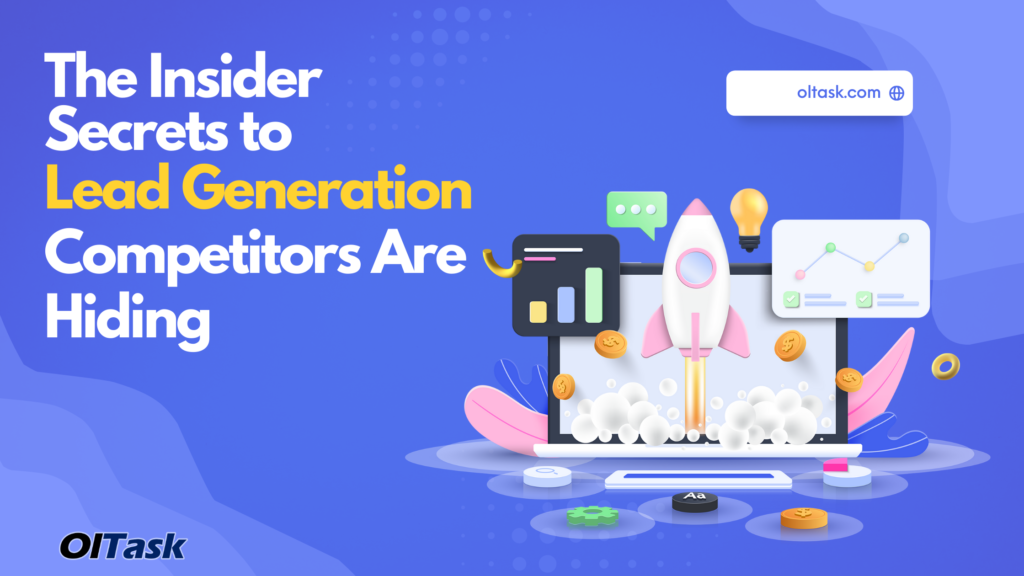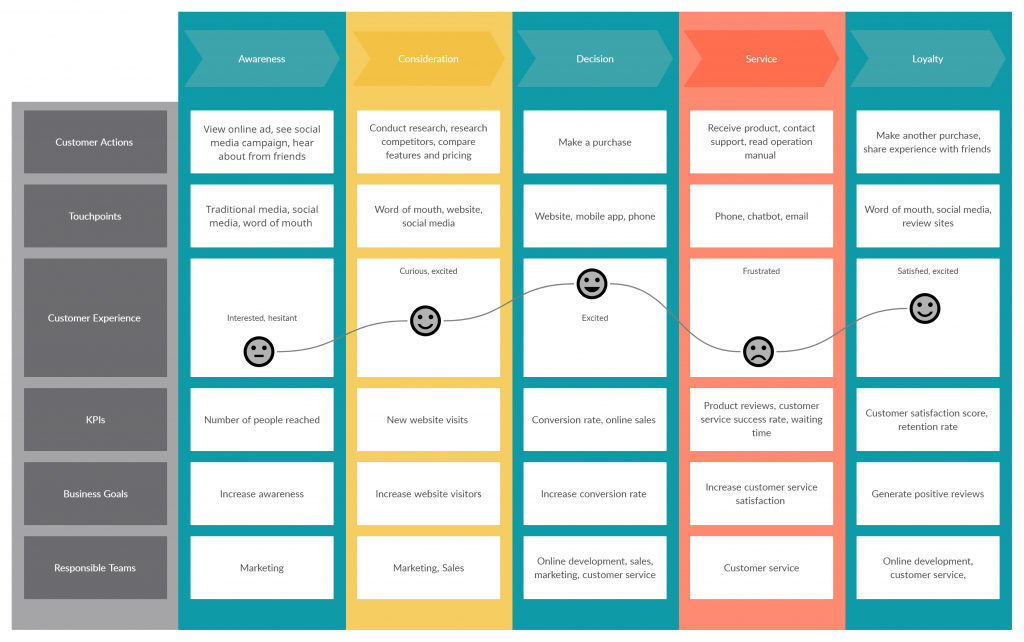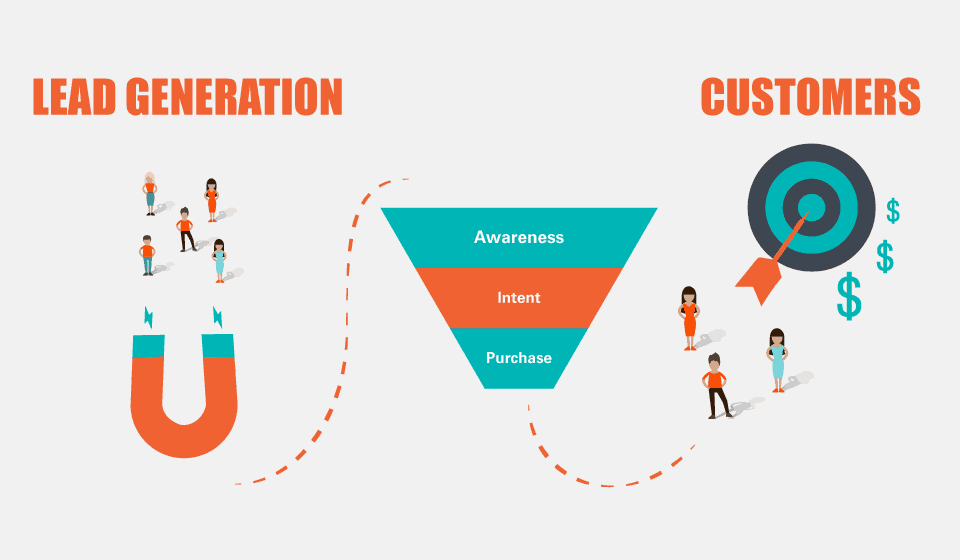Boost Success with Lead Generation The Ultimate Guide

As businesses pivot towards more dynamic and data-driven strategies, lead generation remains an indispensable component of a successful marketing mix.
But what exactly does it entail, and how can you employ it to enhance your business operations?
This ultimate guide has you covered. Read on to elevate your understanding and execution of lead generation.
What is Lead Generation?
At its core, lead generation is the methodical approach of capturing interest in a product or service for the purpose of nurturing and driving this interest towards actions that contribute to revenue. Unlike a mere ‘click’ or ‘impression’ which serves as vanity metrics, a lead indicates conscious engagement and at least minimal willingness to learn more about what you offer.
The Process: More Than Just Names and Emails
- Attention Capture: This is the initial interaction, often through content like blog posts or webinars, social media posts, or targeted advertising.
- Interest Quantification: This involves tracking engagement such as page dwell time or content downloads, indicative of interest level.
- Information Exchange: Prospects fill out forms, giving you their contact details in return for value (e.g., a free e-book).
- Lead Scoring: This advanced step involves assigning numerical values to leads based on their actions and behaviors, helping the sales team prioritize follow-ups.
Data-Driven Insights

According to HubSpot, 61% of marketers say generating traffic and leads is their top challenge. This stat highlights the critical role of lead generation in today’s business landscape. With an effective lead generation strategy, you can mitigate this challenge substantially.
Why It’s More Than Just a Buzzword
Lead generation is a measurable, scalable, and adaptable process. With evolving algorithms and customer behaviors, it is an ongoing strategic operation that requires constant adjustments. It’s not a one-off tactic but an integrated part of your marketing ecosystem.
Why Do I Need Lead Generation for My Business?
In the digital age, consumer behavior is ever-changing, and the competition is fierce. For businesses aiming to not only capture attention but also drive conversions, lead generation is not optional—it’s essential. Let’s delve into why lead generation is a critical aspect of any business strategy, particularly focusing on the pain points experienced by our target personas.
Bridge the Gap Between Marketing and Sales
Marketing may generate traffic, but lead generation is the glue that bonds marketing and sales. For example, let’s say your marketing team’s PPC campaign brings in 1,000 website visits per day. Without a lead generation strategy, these visitors remain anonymous, and the chances of converting them diminish.
Optimize Marketing Spend
One of the main concerns for businesses, especially smaller ones, is getting the most out of their marketing budget. Lead generation helps in this aspect by focusing on targeted audiences. According to HubSpot, businesses that nurture leads make 50% more sales at a cost 33% less than non-nurtured leads.
Enhance Customer Lifetime Value (CLV)
It costs five times more to acquire a new customer than to retain an existing one, according to Forrester Research. A robust lead generation strategy not only acquires new leads but also nurtures existing relationships, thereby increasing Customer Lifetime Value (CLV).
Achieve Scalability
One major challenge faced by growing businesses is scalability. Lead generation provides a structured approach that can be scaled up or down, depending on your business needs. For example, if you aim to enter new markets, a targeted lead generation campaign can be ramped up with localized content and outreach.
What Are the Benefits of Lead Generation?
When executed correctly, lead generation is not just another marketing term; it’s a multifaceted approach to drive revenue, customer engagement, and brand loyalty. From enhancing your bottom line to improving customer relations, let’s break down the specific benefits of incorporating a robust lead generation strategy.
Increased Sales and Profit Ratio
While traditional advertising casts a wide net, lead generation is akin to fishing with a spear. According to Marketo, businesses that nurture their leads see a 450% increase in qualified prospects, resulting in a higher conversion rate. This specificity amplifies your sales volume and, in turn, increases profitability.
Precise Customer Segmentation
Understanding your customer is key to any successful business strategy. With lead generation, you can utilize data analytics to categorize potential customers based on specific variables such as their buying behavior, location, and much more.
For instance, using customer relationship management (CRM) software, you can automate this segmentation, allowing for hyper-targeted marketing campaigns that resonate with specific customer subsets.
Cost-Efficiency
Every penny counts in today’s business environment. According to HubSpot, lead generation through inbound methods can cost 61% less than outbound methods.
By focusing your resources on individuals who have already shown an interest in your services, you minimize wastage of resources and optimize your advertising budget.
Scalability and Adaptability
One of the common pain points for our businesses is the ability to scale their operations. A well-designed lead generation strategy can evolve alongside your business.
Tools such as automated email marketing and advanced SEO practices can be adjusted as your customer base grows, providing a framework that’s both scalable and adaptable.
Focused Business Intelligence
Accurate data is a treasure trove of insights that can guide business decisions. Lead generation offers robust analytics capabilities, helping you understand not just who your customers are but also why they are interested in your product or service.
Google Analytics, for example, can show you the customer pathways that lead to conversions, enabling you to refine your future strategies.
What are the most effective lead generation strategies?

Navigating the myriad of lead generation strategies can feel like walking through a maze. Knowing which avenues are effective for your business is crucial. Let’s drill down into some of the most impactful methods, supported by solid statistics and unique insights, to help your business cultivate a fertile ground for leads.
Content Marketing: Authority Through Education
Content marketing isn’t just about blog posts; it’s a multifaceted approach that includes various forms of content like eBooks, whitepapers, webinars, and videos. It serves as an educational tool that addresses the issues your potential customers face, positioning you as a thought leader in your industry.
- Why It Works: According to DemandMetric, content marketing costs 62% less than traditional marketing and generates about 3 times as many leads.
- Pro Tip: Create a series of whitepapers that tackle industry-specific challenges. Distribute them through LinkedIn groups where your target audience often engages.
Search Engine Optimization (SEO) and Search Engine Marketing (SEM)
SEO and SEM are about leveraging the power of search engines to get in front of potential customers. While SEO aims to improve your organic rankings, SEM focuses on paid advertising.
- Why It Works: 68% of online experiences begin with a search engine. Ensuring that you rank high on these platforms is imperative for visibility.
- Pro Tip: Target long-tail keywords that have less competition but show high intent. These are easier to rank for and often lead to higher conversion rates.
Social Media Advertising
Platforms like Facebook, Instagram, and LinkedIn allow you to target specific demographics, right down to job title, location, and even interests. This is a direct and effective way to put your brand in front of potential leads.
- Why It Works: Facebook Ads have an average CTR (Click-Through Rate) of 0.9%, and LinkedIn Ads can deliver a CTR of up to 0.78%. These platforms have established audiences that are segmented and easy to target.
- Pro Tip: For B2B companies, use LinkedIn’s Matched Audiences feature to retarget website visitors, and custom lists based on your CRM data.
Email Marketing: The Underrated Powerhouse
Often considered old school, email marketing remains an incredibly effective strategy for lead generation when done right.
- Why It Works: Emails have an ROI of $42 for every dollar spent, according to the Data & Marketing Association.
- Pro Tip: Segment your email lists based on customer interaction with your site. Personalized email sequences that follow a user’s path through your sales funnel can be incredibly effective.
How OlTask Can Help
While these strategies are effective, they require specialized skills and a considerable amount of time to implement and manage. OlTask can take over this burden by providing skilled remote staff in areas like outbound sales and SEO.
We integrate seamlessly into your operations, making it easier for you to focus on core business functions while we supercharge your lead generation efforts.
How do I implement lead generation in my business?
Implementing a lead generation strategy can be complex but extremely rewarding when done right. In this section, we delve into the nuts and bolts of setting up a successful lead generation process that directly addresses the pain points of your target audience, like inefficient marketing spends and lack of qualified leads.
Step 1: Clearly Define Your Objectives and KPIs
Knowing where you want to go is the first step to getting there. Define measurable KPIs to evaluate your lead generation strategy’s effectiveness.
- Lead Volume: Aim for a specific number of new leads per month.
- Lead Quality: Measure this by tracking the percentage of leads that convert into sales.
- Cost Per Lead (CPL): Keep tabs on your marketing expenditure by calculating the average cost to acquire a single lead.
Step 2: Identify Your Target Audience
Your strategy is only as good as its targeting. Knowing who to target minimizes waste and maximizes ROI.
- Demographics: Age, gender, location, etc.
- Psychographics: Interests, lifestyle, values, etc.
- Behavioral Traits: Purchase history, website interaction, etc.
Step 3: Choose the Right Channels
Not all platforms yield the same ROI. Select the channels that your target audience frequents the most.
- Search Engines: Google Ads and SEO strategies.
- Social Media: Platforms like LinkedIn for B2B or Instagram for B2C.
- Email: Still one of the most effective channels with an average ROI of 42:1.
Step 4: Create High-Quality Content
Content is the bait that attracts your leads. Craft value-packed content that solves problems and offers solutions.
- Blogs: Address pain points and offer solutions.
- Webinars: Discuss industry trends and how your product/service fits in.
- E-books: Deep dives into subjects your target audience cares about.
Step 5: Set Up a Lead Capture System
Now that you’ve attracted potential leads, you need a system in place to capture their information.
- Landing Pages: Use compelling CTAs and forms.
- Chatbots: Deploy them to engage visitors and collect data.
- Opt-in Forms: On blogs or content offers.
Step 6: Lead Scoring and Qualification
All leads are not created equal. Implement lead scoring to prioritize high-value leads.
- Engagement Metrics: Page visits, form submissions, etc.
- Demographic Information: Job title, industry, etc.
- Lead Temperature: Hot, warm, or cold.
Step 7: Lead Nurturing and Conversion
Converting leads is the end game. A well-nurtured lead is more likely to convert into a paying customer.
- Email Sequences: Personalized and targeted follow-ups.
- Retargeting Campaigns: To recapture the leads that didn’t convert.
- Sales Calls: For high-value leads.
Step 8: Monitor, Analyze, and Optimize
The only constant in marketing is change. Regularly review your strategies to see what’s working and what isn’t.
- Monthly Reviews: To assess the KPIs.
- A/B Testing: For landing pages, emails, and ads.
- Feedback Loop: Collect and implement feedback for continuous improvement.
How OlTask Can Help: We specialize in outbound sales and SEO services, which can significantly help in steps 3 and 4 by leveraging our specialized staff. OlTask can manage these key components, enabling you to zero in on core business operations and strategy.
What are the common lead generation challenges and how to overcome them?
Lead generation is not without its hurdles, especially in an ever-evolving digital landscape. For businesses aiming for growth, these challenges can significantly impede progress. This section dives deep into the common issues that businesses often encounter, and offers granular, actionable solutions to overcome them.
Challenge 1: Low-Quality Leads
It’s easy to get lost in the numbers and think more leads equate to more sales. However, the quality of leads matters more than quantity.
Solution: Lead Scoring and Qualification
- Implement Lead Scoring: Use criteria such as behavioral triggers and demographic information to rate the quality of a lead.
- Educational Content: Create content that educates potential customers, thus filtering out those who aren’t a good fit for your service.
Challenge 2: High Customer Acquisition Costs (CAC)
When the cost of acquiring a customer surpasses the value they bring, your marketing ROI takes a hit.
Solution: Optimize Ad Spending and Targeting
- Perform A/B Tests: Regularly run split tests on your ads to see which ones perform best and then allocate your budget accordingly.
- Use Lookalike Audiences: If you’re advertising on platforms like Facebook, create lookalike audiences based on your existing customers to find more cost-effective leads.
Challenge 3: Ineffective Use of Data
Many businesses collect data but fail to use it effectively for lead generation.
Solution: Data-Driven Decision Making
- Integrate Analytics Tools: Use advanced tools like Google Analytics and CRM systems to collect, monitor, and analyze data.
- Leverage Predictive Analytics: Use historical data to forecast future behavior and tailor your strategies accordingly.
Challenge 4: Maintaining Lead Engagement
A lead that isn’t nurtured through the funnel is likely to drop out.
Solution: Automated Follow-Ups and Personalization
- Use Email Drip Campaigns: Set up automated sequences to keep leads engaged with timely, relevant content.
- Leverage Personalization: Use data-driven insights to tailor your interactions based on the specific needs and behavior of each lead.
How to measure and analyze the success of lead generation?
In the digital age, it’s not enough to just generate leads; businesses need to measure and analyze their effectiveness to ensure optimal ROI. By comprehending key metrics, companies can make informed decisions, optimize strategies, and ultimately, drive better results. Here’s a deep dive into understanding and utilizing these metrics.
1. Conversion Rate: The Core Metric
Conversion rate illustrates the effectiveness of your lead generation efforts. It’s the percentage of visitors who take a desired action, such as filling out a form or making a purchase.
- How to Calculate: (Number of Conversions / Total Visitors) x 100
- Industry Insight: While average conversion rates can hover around 2-5%, top-performing websites often see rates above 10%.
2. Cost Per Lead (CPL): Evaluating Cost-Efficiency
CPL is pivotal for businesses mindful of their marketing budgets. By understanding how much it costs to acquire a single lead, companies can adjust strategies to be more cost-effective.
- How to Calculate: Total Cost of Campaign / Number of Leads Acquired
- Real-World Example: If you spend $1000 on a marketing campaign that generates 250 leads, your CPL is $4.
3. Lead-to-Sale Conversion Rate: Tracking Quality
This metric digs deeper, showing the percentage of leads that turn into paying customers. A high rate indicates quality leads, while a low rate may signal a misalignment between marketing and sales.
- How to Calculate: (Number of Sales / Total Leads) x 100
- Pain Point Addressed: It’s frustrating when leads don’t translate to sales. By focusing on this metric, businesses can pinpoint where the disconnect lies.
4. ROI: The Ultimate Measure
ROI gives a bird’s eye view of the profitability of your lead generation campaigns, balancing the revenue earned with the costs incurred.
- How to Calculate: (Net Profit / Cost of the Campaign) x 100
- Statistical Insight: According to HubSpot, companies that calculate ROI are 1.6 times more likely to receive higher budgets.
Lead Scoring: Beyond these metrics, considering a lead scoring system can further refine your understanding. Assign values to leads based on their behavior and characteristics. Those with higher scores are deemed more likely to convert, helping sales teams prioritize their efforts.
Implementing a Lead Generation Strategy for Success
Instead of wrapping up, let’s talk next steps:
- Audit Your Current Strategy: If you have an existing strategy, evaluate its effectiveness.
- Set a Budget: Know how much you’re willing to spend and allocate resources wisely.
- Engage Professionals for Maximum Impact: This is where specialized services can make all the difference.
How OlTask Can Help: Our team at OlTask provides specialized outbound sales and abandoned cart recovery services, among other things, to ensure that your lead generation strategies are not just planned but effectively executed.
Ready to boost your lead generation success? Don’t leave your growth to chance. Reach out to our experts at OlTask today and let’s build a robust lead generation strategy tailored for your business.
By following these steps and leveraging specialized services like OlTask’s, you’re setting your business up for greater success in the competitive digital landscape.

